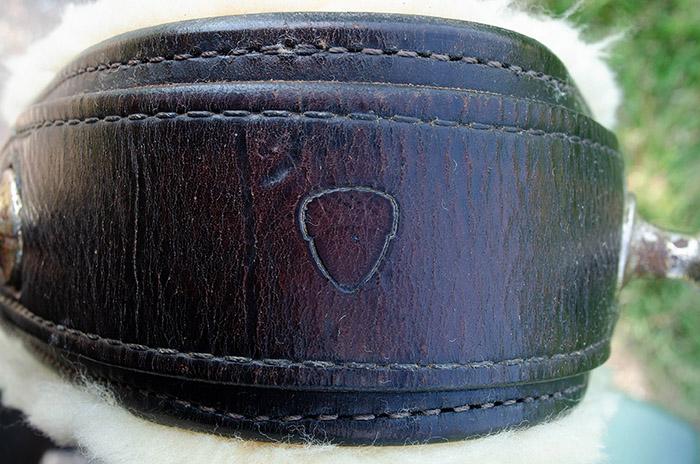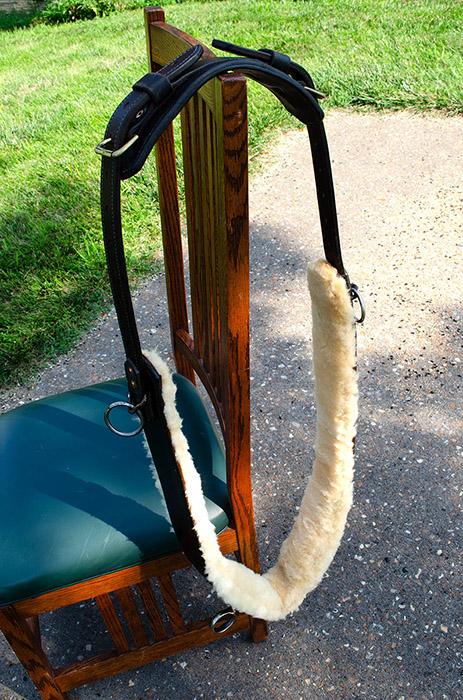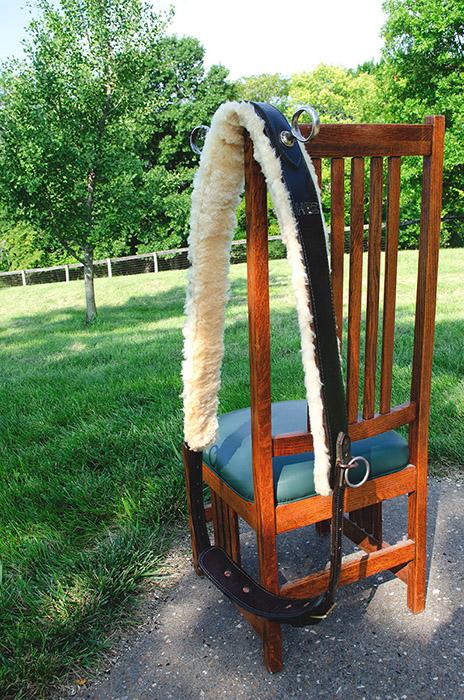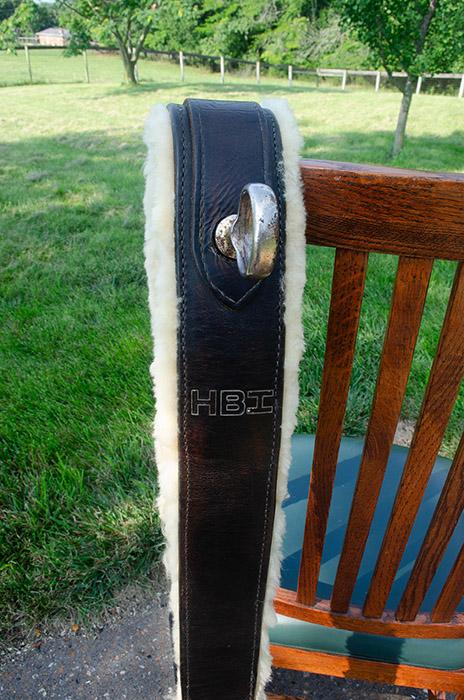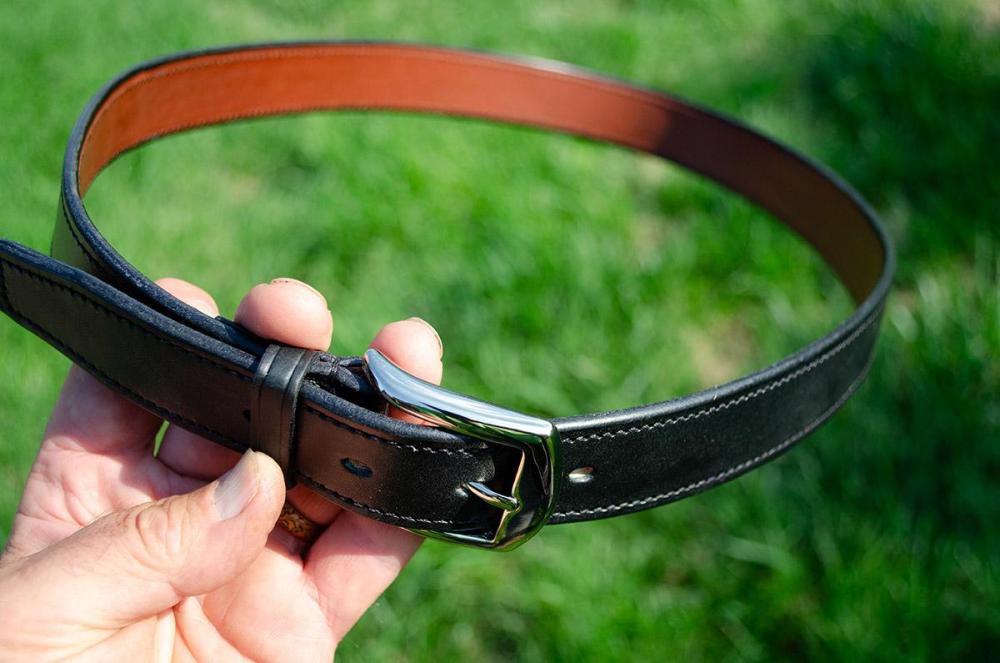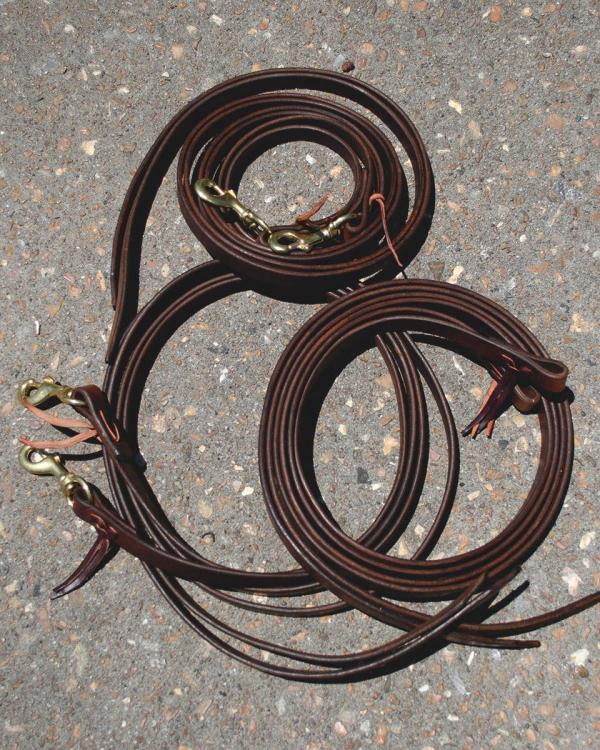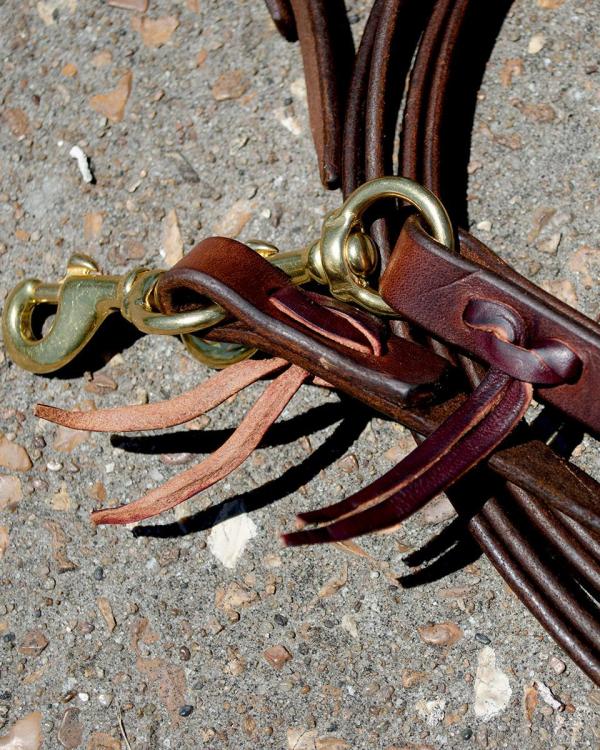-
Posts
1,282 -
Joined
-
Last visited
Content Type
Profiles
Forums
Events
Blogs
Gallery
Everything posted by TomE
-
@CdK, I can send you more Resolene when you run low. My short experience with it was watching it lift the dye and discolor the thread on a project that I was previously proud of. I swore off acrylic finishes, for better or worse, but still suffer from flashbacks when using light colored thread.
-
Thank you, Jonas. I learned something about sewing shearling - it takes longer. I offered to make a leather covered foam pad for the surcingle, similar to a padded girth, but the client wanted the original look.
-
I think the machine stitching reflects the type of needle. See the LR point needle at this site https://www.schmetz.com/en/industrial-needles/needle-compass/cutting-points/. I would sew by hand as @BlackDragon suggested, using a bonded thread as for a machine and waxing the thread. I can do a neater job repairing horse tack by hand than trying to run over the stitches with a machine.
-
A damp piece of canvas removed the gummy residue from my burnisher.
-
I use this adhesive sealer on some projects to recreate the moss-back (pasted back) on bridle leather after splitting the thickness. Work it into the leather with a glass slicker to paste the fibers together. Seems to wear fairly well on horse tack. https://campbell-randall.com/product/sup-bt639-g-leather-finish-for-sealing-flesh-side-moss-back-suede-1-gal Since you've already applied burnishing gum maybe a surface finish would be better for correcting this project. Lincoln Stain Wax in neutral (no stain) will provide some shine and might serve as a barrier to contain the black Tokonole. It's a high end shoe polish and it smells nice!
-
Covering my bench with HDPE was a big help for cutting out projects. Menards has 4x8 x 1/4" sheets in a white color that brightens up my shop. @Northmount taught me that a Google search of this site using the syntax below is more efficient than using the internal search engine. Type in the Google search bar: site leatherworker.net <your search terms here>
-
McMaster-Carr has sanding drums and sleeves. https://www.mcmaster.com/products/sanding-drums/ One thing I like about the Cobra burnisher is the ability to adjust the speed. Need to control friction-heat to get a good result. The right amount of water and saddle soap on the edge is important, and I run the burnisher at about half speed. I usually finish the edge by hand with canvas and a burnishing gum or solution. Also, the wooden burnisher on the MP has that wide flat section that I use often for multiple layers of leather straps.
-
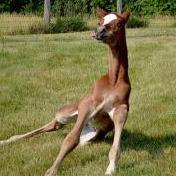
Purposes of leather pieces on skirt with fleece
TomE replied to Mdolfan's topic in General Saddlery Discussion
I feel your pain. Just finished hand sewing a shearling liner on a surcingle, and didn't figure enough labor for the sewing. I normally just pass the waxed thread through my fingers to burnish the wax, but that was a total fail for shearling. Clumps of wool pulled through the stitch holes. Burnishing with brown paper did the trick, even for cobbler's sticky wax (beeswax + pine resin). After that, I didn't have a problem with the wool getting in the way. I inserted/twisted an awl to enlarge each hole, put a needle through the front side and twirled it a little, and inserted the needle from the backside as I withdrew the needle from the front (feeling my way into the backside), then ran the needle through from the front side and pulled up the stitch. Went pretty smoothly once I got the feel of finding the holes from the backside. I was able to use a stitching horse for my project and that no doubt helps my consistency. -
Been doing repairs lately instead of making things. Replaced the fleece, billets, and girth buckle strap on this 30 year old surcingle. Hand sewing the shearling (using the existing holes) probably took longer than it would require to make a new surcingle with a sewing machine, but that wasn't the assignment. Does anyone recognize this maker's mark (acorn)? Made in the mid-1990s, possibly in the Saint Louis area. The HBI stamp is harmony, balance, and impulsion. The client's trainer at the time had these surcingles made for her students.
-
I also use wet/dry abrasive paper in grits 320-1500. I wrap it around jeweler's files, rods, metal plate, etc to get into tight spaces. A small pointed diamond hone can also be useful, and some Arkansas slips with rounded or beveled edges. Sharpeningsupplies.com has the hones and slips. Card stock and leather edges coated with rouge are also useful for stropping some tools. My go-to strop is a large square of saddle skirting glued to plywood with some non-skid rubber feet.
-
Learning to sharpen a sewing awl is foundational knowledge as you learn to hand sew. I use inexpensive Osborne awls and hafts. They start out roughly the same width/size and become smaller with repeated sharpening, so I now have several sizes for different thread sizes. The Stohlman book on hand sewing is a good resource, and the Nigel Armitage videos cover similar concepts. You can buy a sharp awl from @bruce johnson to learn what the desired endpoint is.
-
I have a 60 mm Olfa rotary cutter that had no problems cutting out 7 oz apron split for a farrier's shoeing apron. Today I am using it to trim a veg tanned shearling liner. I mainly use it on 3-5 oz chrome tanned leathers. New blades cost about $6 and the original blade is sharp after about a year of use. I use it on a bench covered with HDPE. Greatly prefer the rotary cutter to a round knife, trim knife etc. for straight cuts and gradual curves on stretchy leathers. My wife tells me that Olfa is the original rotary cutter, which is why I bought it.
-
I agree with @zuludog. I rarely use a stitch groover and usually mark my stitch lines with dividers or a crease, whether sewing by hand or machine. I don't like the idea of cutting the grain of the leather. Maybe for some projects (shoes?) it's important to recess the thread, but I rarely see the thread fail in horse tack. It's usually the leather wrapping around hardware that breaks. An exception is old linen thread that has rotted. I'd be interested in learning from others why they groove their stitch lines.
-
I would glue and sew the liner when sewing the strap. I normally trim the liner and finish the edges after gluing and before sewing. I have made guitar straps using 2 layers of bridle leather (6 oz + 3 oz liner). For the next guitar strap, I'll probably use the oil tanned leather shown below as a liner. It splits and sews nicely, and burnishes to blend with the bridle leather strap. The oil tan leather is from the SB Foot tannery and sold by Beiler's as "chrome tanned oiled sides." It was about 5 oz and I split the liner to ~3 oz for this belt.
-
Bridle leather has a more refined appearance (glossy surface) and is not as weatherproof as harness leather, which is stuffed with lots of fat/wax. Bridle leather also has a smooth, pasted back (moss-back) that facilitates maintenance of tack like bridles made from a single layer of leather. I make reins for English tack out of bridle leather to match the bridles I make. I agree with @sheathmaker that harness leather is the better choice for western reins. Good weight and feel, and stands up to abuse. Hermann Oak Leather Co and Wickett & Craig Leather make nice harness leathers in a variety of colors. An experienced western tack maker (not me) will have a die to click out the slobber straps in one step. I would talk with them about the type of leather you want your reins made from. @Northmount can advise you about a posting to connect with a "rein maker."
-
Well said, @sheathmaker. The newest pictures show knots exposed on the backside of the stitching, and some very rough edges. Doesn't strike me as a quality job. Given the workmanship and the curling of the straps I suspect that the quality of the leather might also be an issue.
-
Thanks, Jonas. I am using a cobbler’s wax (pine resin + beeswax) for the thread. This is black nasty looking stuff. Come to think of it the decaying linen thread is coated with something dark, which I had assumed was accumulated dirt. Thanks for checking your sources. Thanks, Chuck. That’s a neat idea. Seems unlikely to make the rivet more secure so I was stumped. I made a shoeing apron out of chrome tanned apron split and had wondered if the copper rivets would discolor the leather. The pitch would be too messy for that project. This surcingle is 1-2 layers of 11-12 oz leather dyed dark chocolate brown, almost black.
-
I am repairing a heavy surcingle and the copper rivets appear to be coated in a pitch-like substance. As I ground off the tip of a rivet with a Dremel tool a black, tarry liquid oozed from underneath the burr. The tar is solid a room temperature. I haven't found any mention of using pitch in the harness making books I have, or from a Google search. I am interested in why this would be done, and the type of pitch/tar used in saddlery/harness work. Thanks for the information.
-
Silver also has antimicrobial activity. Silver sulfadiazine is a wound treatment. Perhaps the Lone Ranger chewed on his silver bullets. The farriers I have asked about copper coated nails said they don't know if they work, but they look cool and they can charge more.
- 25 replies
-
- shoe making machinery
- cobbler techniques
- (and 2 more)
-
Thank you for sharing your knowledge. Great information and fun stories! I look forward to learning more. Your description of nails reminds me of horse shoe nails. There is a (dying?) fad of coating nails with copper that supposedly inhibits growth of bacteria in the nail hole. Maybe they also keep the farrier's breath fresh?
- 25 replies
-
- shoe making machinery
- cobbler techniques
- (and 2 more)
-
A picture would help to understand how the leather is curling/twisting. Is it consistent with cutting the reins in a spiral pattern? That would be a major fail in my book. Reins should lie flat and have minimal stretch. Cut lengthwise from the back of the cow. The split reins below were made from 11 oz harness leather, which is heavy and stretch-resistant, and latigo strings. I requested a "rein selection" side (= a big cow) from the Hermann Oak tannery and was able to get 3 pr of 7-1/2 ft reins from the top of the side. Could probably make a few more pair of ~7 ft reins from this side. Harness leather is stuffed with fats/waxes and doesn't take a stamp particularly well, but it is tough and fairly weather resistant. Has the right weight and feel according to the folks that use these reins (I mostly make/repair English tack). If yours don't feel right then I agree you should request your money back.
-
I purchased a (barely) used Class 26 several years ago and have had no problems. I am impressed with how handy it is, its ability to feed fairly thick material, and ease of setup for thick(er) and thin projects. No problems with matching stitch length in F and R although I mainly use the range of 6-9 SPI.. It's been a good addition and complements the Class 4 that I started with. I think many of the problems you see in the FB group are due to operator error/inexperience. Because the Class 26 is a popular machine for beginners you might find a used machine in your area.
-
This velcro bell boot uses a sandwich of velcro tabs. https://walshproducts.com/products/velcro-bell-boot-with-fleece-147f I haven't tried this one but the price is not much more than plain rubber bell boots, and Walsh is a quality brand. @Silverd's leather boots are a work of art and the closure looks very secure. In my experience, heavy rubber bell boots have the right amount of weight and flex to stay in place on the hoof during work. Thankfully, our shoe puller mare is now barefoot and pregnant so I am not dealing with bell boots as often.
-
Those are beautiful leather bell boots but they wouldn't stay that way on our horses that need them. In my experience it's hard to improve on the utility of one piece rubber bell boots. The velcroed/synthetic boots tend to ride up (at least the ones we've tried) so they don't protect the feet or horseshoes from damage caused by interference. When a horse is a shoe puller they usually wear rubber boots 24/7, on pasture and in the barn, and when working under saddle except in show classes where they are not allowed (so the judge can see the foot movements). So the boots take a beating. I'd find out how/when they are using the boots and why they prefer the velcroed type boots vs slip on rubber boots. If leather bell boots seem workable then I would consider harness leather as a tough, weatherproof choice.
-

Dyed leather is returning to original color??!!
TomE replied to AmericanSon's topic in How Do I Do That?
The book "Tanning Chemistry The Science of Leather" by Covington and Wise has a chapter on dyes. They mention that too much surface reaction during tanning with chromium salts can cause splotchy coloring with dyes or act as a complete resist to dyes. From what I could gather in a quick read the amount of surface reaction with chromium is determined by the tanning conditions (pH, chromium concentration, etc) so dye uptake is a problem with some, but not all chrome tanned leathers. The authors say chrome tanned leathers are cationic (positively-charged) and therefore generally react well with acid dyes. This thread has some information on dyeing chrome tanned leather. A comment by veedub3 in this thread mentions Dharma acid dyes for leather and provides a link. Perhaps they can help.



